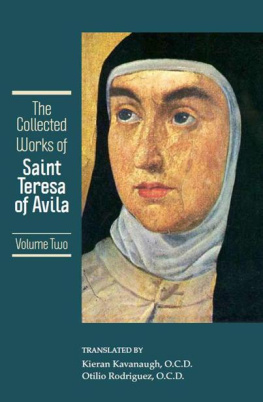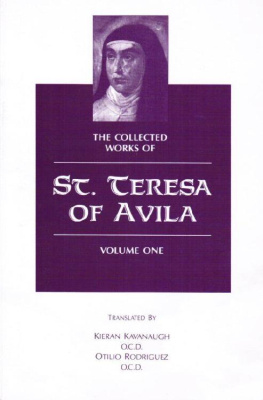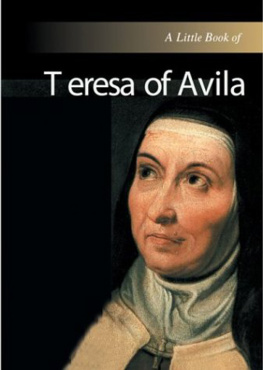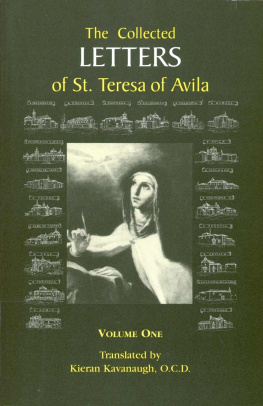
PENGUIN BOOKS
CONTENTS
THE LIFE OF SAINT TERESA OF VILA
S T TERESA was born at vila in 1515. Of good parentage, she entered the Carmelite convent of the Incarnation at vila in Castile when she was twenty-one. Grieved at being parted from her family, she became a nun with determination but without enthusiasm. She progressed well with contemplation and wrote a good deal about the mystical spiritual experiences she underwent without giving them undue significance. A strong influence upon her was the Dominican priest Domingo Baez, who taught her that God can be loved in and through all things.
In middle age, she resolved to found a convent under the Carmelite rule. After many setbacks, St Josephs at vila was opened in 1562, the first house of the reformed or discalced (barefoot) Carmelites. During the next twenty years she travelled the length and breadth of Spain founding seventeen convents in all, often in conditions of great hardship.
Frank, affectionate, lively and witty, St Teresa combined the contemplative religious life with a life of great activity and she recorded both aspects in literary form. The most important of her writings are the Life of herself up to 1562, written at the request of her confessors; the Way of Perfection, intended for the instruction of her own nuns; the Book of Foundations, the high-spirited account of the establishment of her convents, and The Interior Castle. She died at Alba Dc Tormcs in 1582.
J.M. C OHEN translated nine volumes for the Penguin Classics; these have been works by Cervantes, Diaz, Galdos, Montaigne, Pascal, Rabelais and Rousseau. He also edited the Penguin anthologies Latin American Writing Today, Writers in the New Cuba, the Penguin Book of Spanish Verse and the Penguin book of Comic and Curious Verse. He compiled the Penguin Dictionary of Quotations, the Penguin Dictionary of Modern Quotations and published A History of Western Literature (Penguin, 1956). J. M. Cohen was born in 1903 and began writing and translating in 1946. J. M. Cohen died in 1989. The Times obituary described him as one of the last great English men of letters, while the Independent wrote that his influence will be felt for generations to come.
TO
Simon and Dawn
Introduction
T HE autobiography of Santa Teresa is the story of a most remarkable womans entry into the religious life, and at the same time a literary masterpiece that is, after Don Quixote, the most widely read prose classic of Spain. It is a piece of candid self-revelation, written in the liveliest and most unforced conversational prose. The saint herself states that it was composed in the first place at the request of her confessors, who required some account of her rare experiences to be circulated among those religious of a like bent, and who needed it also, in a day when accusations of heresy were frequent, as proof positive of her complete orthodoxy and utter obedience to the teachings and dictates of the Church. But although she herself protests that she lacked the time and leisure for her unwelcome task, and that she would have been better employed spinning or doing the household work in her poor convent, she was undoubtedly a born writer to whom words came freely and fast, and who took a craftsmans delight in them.
The book as we have it gives an account of Teresas life up to her fiftieth year, 1565, but it was certainly begun some seven or eight years before the date when it was asked for by her confessors, and was addressed in the first place to those four close spiritual friends whom she mentions in Chapter 16 as her fellow members of the Five. Much of it was, in fact, written at Toledo, during the time that Teresa spent there as the guest of the wealthy Doa Luisa de la Cerda, about whom she tells us in Chapter 34. In its complete form, however, it first began to pass from hand to hand at the beginning of 1565, and soon Father Baez, the saints confessor at the time and her firm ally and friend, was reproaching her for putting it about rather too freely. He realized, however, that the fault was not hers. Fashionable Spain was extremely interested in this active and forthright reformer of convents.
Much of the books immediate success was the result of its sheer good writing. Teresas thoughts seem naturally to clothe themselves in simple, direct, and picturesque language. Even when she is describing a difficult state of conscience or a very rare supernatural experience, she never fails to find the right homely words, the simple everyday metaphors, that will make it clear to readers whose life has never risen to such levels. Her language flows, as does that of Cervantes, like good talk; and she shares with Cervantes also a taste for proverbs and pithy country sayings. Teresa was a woman of little reading. The Imitation of Christ and Saint Augustines Confessions were two of the few books that she knew well. In her youth, as she tells us, she had been fond also of the romances of chivalry; and perhaps at the same time she read ballads and popular poetry. Latin she could hardly understand; any Latin quotations that occur in the Life are spelt so phonetically as to be almost unrecognizable. Her vocabulary, therefore, is that of a plain person; all grand words are suspect to her. Even many religious terms are lumped together in her mind under the heading of mystical theology, a theoretical science of which she confessed herself to be ignorant.
If Teresas spelling of Latin follows its own phonetic rules, so does her writing of Spanish. Her punctuation was weak, even to the point of non-existence, and this defect has been only imperfectly remedied by her editors. One is seldom in doubt as to what she is saying, but often puzzled by the syntax of her sentences, which abound in unrelated clauses. She does not appear to have re-read what she wrote. Several times in the course of the Life she remarks that she may have mentioned something before. It does not seem to have occurred to her that she could have turned back to see. She never verified her dates, and frequently lost the thread of her narrative when following a digression of consuming interest. A few liberties, therefore, have had to be taken in this translation. Sometimes punctuation has been made to conform with sense, in defiance of the best scholarly readings; and sometimes a bare this or that has had to be expanded, since the subject to which it refers has not in fact been mentioned for several pages.
Although a natural writer and a mistress of metaphor, proverb, and telling image, Teresa was not yet, in this first of her works, expert in literary construction. While setting out to describe both the inner and the external events of her life, she was chiefly concerned to tell of her conversion to the contemplative life, at the age of forty, and her subsequent progress in it. She was not content, therefore, to follow a purely autobiographical thread for very long. For the first ten chapters she does so, though without dwelling in great detail on any worldly event, or giving more than a passing description of the people she met. Proper names are very few, most of her friends being referred to merely as a cousin of mine, or a certain learned Jesuit who was then my confessor, or merely, a sister in the convent where I was. Nevertheless these almost anonymous characters are frequently called to life in a single line.













